Feasibility and Mechanism of Deep Heavy Oil Recovery by CO2-Energized Fracturing Following N2 Stimulation
Abstract
1. Introduction
2. Experiments
2.1. Experimental Materials and Instruments
- Formation oil: The formation oil used for the tests was obtained from actual field sampling of the No. X013 Well in Xinjiang oilfields, China. Its viscosity and density were 102.3 mPa·s and 0.883 g/cm, respectively, at a temperature of 50.0 °C and a pressure of 0.1 MPa.
- Foaming Agent: The foaming agent is AES. Different concentrations of AES solutions (0.5%, 1.0%, 2.0%, 3.0% and 4.0%) were prepared.
- Air source: In this experiment, high purity nitrogen with an oxygen content less than 3 ppm was used as the gas source.
- Brine: In the experiments, synthetic brine was prepared according to the composition of the formation water. The pH of the brine was 7.3, and the concentration of total dissolved solids (TDS) was 6596.1 mg/L.
- Experimental instruments: beaker, measuring cylinder (1000 mL), magnetic mixer, Waring blender (speed 0–20,000 r/min), microscopic visualization model.
2.2. Experimental Procedure
2.2.1. Foaming Performance Experiments in Crude Oil
- First, make a solution of AES foaming agent in concentrations of 0.5%, 1.0%, 2.0%, 3.0% and 4.0%.
- Pour the foaming agent (50 mL) and the crude oil (50 mL) into a beaker and place the beaker over a magnetic stirrer to mix the foaming agent with the crude oil.
- The mixed solution was poured into a Waring blender and stirred at a speed of 7000 r/min for one minute at a temperature of 25.0 ℃ and 0.1 MPa.
- Immediately pour it into 1000 mL measuring cylinder, seal it with plastic wrap, and record the foam volume (V) when stirring is stopped and the time (t) it takes to separate 50 mL of liquid from the foam.
2.2.2. 2D Microscopic Visualization Experiment
- Model installation and debugging: Install the glass etching chip in the high pressure visible kettle; the confining pressure is controlled by the confining pressure tracking pump to make it higher than the internal pressure of the model (11 MPa). The confining pressure is set to 13 MPa. Put the connected glass etching chip under the microscope, open the installed microscope software on the computer, adjust the microscope’s aggregation position and magnification, and the high-speed camera can collect clear micro-scale channel images.
- Model vacuumization: After the micro-pore etching model and experimental process pipeline are vacuumed for 2.0 h, the injection and outlet valves are closed to ensure that there is no air in the visual model of micro scale channels.
- Model saturated oil: Adjust the backpressure unit to the simulated pressure of the formation, and the high-pressure injection pump saturates the oil at a speed no higher than 0.002 mL/min until the model and the pores are filled with oil. When the micro-pores are small, kerosene saturation is usually carried out first and then formation simulation oil saturation is carried out.
- Simulate the process of N foam flooding: N foam displacement experiments were performed at 36.0 ℃ and 11 MPa. The foaming agent slug is injected at a rate of 0.002 mL/min, and the injection rate of N is adjusted to simulate different injection gas/liquid ratios. During the process of displacement, we should pay attention to the timely acquisition of images, and observe the number, morphology and flow characteristics of bubbles under different gas/liquid ratios with a microscopic camera.
2.3. Results and Discussion
2.3.1. Foaming Performance Experiments in Crude Oil
2.3.2. 2D Microscopic Visualization Experiment
3. Numerical Simulation
3.1. Model
3.2. Compare of Different Fracturing Techniques
3.3. Parameter Optimization in the Primary Production Stage
3.3.1. Optimization of Fracture Network Parameters
3.3.2. Optimization of CO Fracturing Parameters
3.4. Stage of N Foam Huff-N-Puff
3.4.1. Timing of the N Foam Huff-N-Puff Stage
3.4.2. Solvent Slug Volume
3.4.3. Cyclic N Injection Volume
3.4.4. Fluid Concentration of N Foam
3.4.5. Gas/Liquid Ratio of Huff-N-Puff
3.4.6. The Soaking Times of Huff-N-Puff
4. Conclusions
- The experimental results show that a high concentration of foaming agent can improve the foaming volume and prolong the half-life in the presence of oil during primary production, and the optimal foaming agent concentration is 3.0∼4.0%.
- N foam has a selective plugging effect on large pores and can achieve the mobilization of residual oil. However, the change in the injected gas/liquid ratio does not influence the shape of N foam; it only affects the number of bubbles per unit area. The number of bubbles per unit area increases with the increase in gas/liquid ratio, and the optimal gas/liquid ratio is 3.0∼4.0.
- Numerical simulations show that CO-energized fracturing technology takes into account the advantages of fracturing and oil viscosity reduction, and the recovery factor of post-fracturing primary production can reach approximately 13.7%.
- N foam huff-n-puff technology is applied to improve the recovery factor in 5∼6 years, and the final recovery factor can reach approximately 35%.
Author Contributions
Funding
Institutional Review Board Statement
Informed Consent Statement
Data Availability Statement
Acknowledgments
Conflicts of Interest
References
- Yushi, Z.; Shicheng, Z.; Tong, Z.; Xiang, Z.; Tiankui, G. Experimental investigation into hydraulic fracture network propagation in gas shales using ct scanning technology. Rock Mech. Rock Eng. 2016, 49, 33–45. [Google Scholar] [CrossRef]
- Yushi, Z.; Xinfang, M.; Shicheng, Z.; Tong, Z.; Han, L. Numerical investigation into the influence of bedding plane on hydraulic fracture network propagation in shale formations. Rock Mech. Rock Eng. 2016, 49, 3597–3614. [Google Scholar] [CrossRef]
- Kizaki, A.; Tanaka, H.; Ohashi, K.; Sakaguchi, K.; Matsuki, K. Hydraulic fracturing in inada granite and ogino tuff with super critical carbon dioxide. In Proceedings of the ISRM Regional Symposium-7th, Asian Rock Mechanics Symposium, Seoul, Republic of Korea, 15–19 October 2012. [Google Scholar]
- Inui, S.; Ishida, T.; Nagaya, Y.; Nara, Y.; Chen, Q. Ae monitoring of hydraulic fracturing experiments in granite blocks using supercritical CO2, water and viscous oil. In Proceedings of the 48th U.S. Rock Mechanics/Geomechanics Symposium, Minneapolis, MI, USA, 1–4 June 2014. [Google Scholar]
- Heng, S.; Yang, C.; Wang, L.; Daemen, J. Experimental study on the hydraulic fracture propagation in shale. Curr. Sci. 2018, 115, 465–475. [Google Scholar] [CrossRef]
- Yang, Y.; Liu, H.; Mao, W.; Song, Z.; Wang, H. Study on the impact pressure of swirling-round supercritical CO2 jet flow and its influencing factors. Energies 2020, 14, 106. [Google Scholar] [CrossRef]
- Phillips, A.M.; Couchman, D.D.; Wilke, J.G. Successful field application of high-temperature rheology of CO2 foam fracturing fluids. In Proceedings of the SPE/DOE Joint Symposium on Low Permeability Reservoirs, Denver, CO, USA, 18 May 1987. [Google Scholar]
- Liu, H.; Feng, W.; Zhang, J.; Meng, S.; Duan, Y. Fracturing with carbon dioxide:application status and development trend. Pet. Explor. Dev. 2014, 41, 466–472. [Google Scholar] [CrossRef]
- Greenhorn, R.C.; Li, E. Investigation of high phase volume liquid CO2 fracturing fluids. J. Can. Pet. Technol. 1985, 2, 20. [Google Scholar]
- Ribeiro, L.H.; Li, H.; Bryant, J.E. Use of a CO2-hybrid fracturing design to enhance production from unpropped-fracture networks. SPE Prod. Oper. 2017, 1, 28–40. [Google Scholar] [CrossRef]
- Li, S.; Zhang, S.; Zou, Y.; Zhang, X.; Liu, C. Experimental study on the feasibility of supercritical CO2-gel fracturing for stimulating shale oil reservoirs. Eng. Fract. Mech. 2020, 238, 107276. [Google Scholar] [CrossRef]
- Li, S.; Zhang, S.; Ma, X.; Zou, Y.; Li, N.; Wu, S.; Zhang, Z. Coupled physical–chemical effects of CO2 on rock properties and breakdown during intermittent CO2 -hybrid fracturing. Rock Mech. Rock Eng. 2020, 53, 1665–1683. [Google Scholar] [CrossRef]
- Li, S.; Zhang, S.; Zou, Y.; Ma, X.; Kasperczyk, D. Pore structure alteration induced by CO2–brine–rock interaction during CO2 energetic fracturing in tight oil reservoirs. J. Pet. Sci. Eng. 2020, 191, 107147. [Google Scholar] [CrossRef]
- Lillies, A.; King, S. Sand fracturing with liquid carbon dioxide. In Proceedings of the SPE Production Technology Symposium, Hobbs, Mexico, 8–9 November 1982. [Google Scholar]
- Hawthorne, S.B.; Gorecki, C.D.; Sorensen, J.A.; Miller, D.J.; Harju, J.A.; Melzer, L.S. Hydrocarbon mobilization mechanisms using CO2 in an unconventional oil play. Energy Procedia 2014, 63, 7717–7723. [Google Scholar] [CrossRef]
- Li, S.; Zhang, S.; Ma, X.; Zou, Y.; Li, N.; Chen, M.; Cao, T.; Bo, Z. Hydraulic fractures induced by water-/carbon dioxide-based fluids in tight sandstones. Rock Mech. Rock Eng. 2019, 52, 33223–35540. [Google Scholar] [CrossRef]
- Ishida, T. Acoustic emission monitoring of hydraulic fracturing laboratory experiment with supercritical and liquid CO2. Geophys. Res. Lett. 2012, 39, 16. [Google Scholar] [CrossRef]
- Wang, C.; Liu, P.; Wang, F.; Atadurdyyev, B.; Ovluyagulyyev, M. Experimental study on effects of CO2 and improving oil recovery for CO2 assisted sagd in super-heavy-oil reservoirs. J. Pet. Sci. Eng. 2018, 165, 1073–1080. [Google Scholar] [CrossRef]
- Zou, Y.; Li, N.; Ma, X.; Zhang, S.; Li, S. Experimental study on the growth behavior of supercritical CO2 -induced fractures in a layered tight sandstone formation. J. Nat. Gas Sci. Eng. 2018, 49, 145–156. [Google Scholar] [CrossRef]
- Liu, B.; Wang, Y.; Liang, L. Preparation and performance of supercritical carbon dioxide thickener. Polymers 2021, 13, 78. [Google Scholar] [CrossRef]
- Li, Q.; Wang, F.; Forson, K.; Zhang, J.; Zhang, C.; Chen, J.; Xu, N.; Wang, Y. Affecting analysis of the rheological characteristic and reservoir damage of CO2 fracturing fluid in low permeability shale reservoir. Environ. Sci. Pollut. Res. 2021, 13, 78. [Google Scholar] [CrossRef]
- Trickett, K.; Xing, D.; Enick, R.; Eastoe, J.; Hollamby, M.J.; Mutch, K.J.; Rogers, S.E.; Heenan, R.K.; Steytler, D.C. Rod-like micelles thicken CO2. Langmuir ACS J. Surf. Colloids 2010, 1, 83–88. [Google Scholar] [CrossRef]
- Chiu, K.; Thakur, S.C. Modeling of wellbore heat losses in directional wells under changing injection conditions. In Proceedings of the SPE Annual Technical Conference and Exhibition, Dallas, TX, USA, 6–9 October 1991. [Google Scholar]
- Ramey, H.J. Wellbore heat transmission. J. Pet. Technol. 1962, 14, 427–435. [Google Scholar] [CrossRef]
- Griston, S.; Willhite, G.P. Numerical model for evaluating concentric steam injection wells. In Proceedings of the SPE Western Regional Meeting, Ventura, CA, USA, 8–10 April 1987. [Google Scholar]
- Hasan, R.A.; Kabir, C.S. Aspects of wellbore heat transfer during two-phase flow. SPE Prod. Facil. 1994, 9, 211–216. [Google Scholar] [CrossRef]
- Salehi, M.M.; Safarzadeh, M.A.; Sahraei, E.; Nejad, S. Comparison of oil removal in surfactant alternating gas with water alternating gas, water flooding and gas flooding in secondary oil recovery process. J. Pet. Sci. Eng. 2014, 120, 86–93. [Google Scholar] [CrossRef] [PubMed]
- Qu, M.; Liang, T.; Hou, J. Study on Fluid Behaviors of Foam-Assisted Nitrogen Flooding on a Three-Dimensional Visualized Fracture–Vuggy Model. Appl. Sci. 2021, 11, 11082. [Google Scholar] [CrossRef]
- Liu, Q.; Liu, S.; Luo, D.; Peng, B. Ultra-low interfacial tension foam system for enhanced oil recovery. Appl. Sci. 2019, 9, 2155. [Google Scholar] [CrossRef]
- Wu, W.; Pan, J.; Guo, M. Mechanisms of oil displacement by asp-foam and its influencing factors. Pet. Sci. 2010, 1, 100–105. [Google Scholar] [CrossRef]
- Farajzadeh, R.; Andrianov, A.; Zitha, P. Investigation of immiscible and miscible foam for enhancing oil recovery. Pindustrial Eng. Chem. Res. 2010, 49, 1910–1919. [Google Scholar] [CrossRef]
- Ashoori, E. Fractional-flow theory of foam displacements with oil. SPE J. 2010, 15, 260–273. [Google Scholar] [CrossRef]
- Rossen, W.R.; Zeilinger, S.C.; Shi, J.; Lim, M.T. Mechanistic simulation of foam processes in porous media. In Proceedings of the SPE Annual Technical Conference and Exhibition, New Orleans, LA, USA, 25–28 September 1994. [Google Scholar]
- Di, M.; Yu, J.; Ning, L.; Lee, R. The Application of Nanoparticle-Stabilized CO Foam for Oil Recovery. In Proceedings of the SPE International Conference on Oilfield Chemistry, The Woodlands, TX, USA, 8–10 April 2013. [Google Scholar]
- Lin, Z.; Li, A.; Kai, C.; Tang, J.; Fu, S. Development and evaluation of foaming agents for high salinity tolerance. J. Daqing Pet. Inst. 2012, 81, 18–23. [Google Scholar]
- Lin, Y.; Yang, G. A successful pilot application for N2 foam flooding in liaohe oilfield. In Proceedings of the SPE Asia Pacific Oil & Gas Conference and Exhibition, Adelaide, Australia, 13 September 2006. [Google Scholar]
- Liu, R.; Liu, H.; Li, X.; Fan, Z. The reservoir suitability studies of nitrogen foam flooding in shengli oilfield. In Proceedings of the SPE Asia Pacific Oil and Gas Conference and Exhibition, Perth, Australia, 20–22 October 2008. [Google Scholar]
- Ma, K.; Jia, X.; Yang, J.; Liu, Y.; Liu, Z. Nitrogen Foam Flooding Pilot Test for Controlling Water Cut and Enhance Oil Recovery in Conventional Heavy Oil Reservoirs of China Offshore Oilfield. In Proceedings of the SPE Asia Pacific Oil and Gas Conference and Exhibition, Jakarta, Indonesia, 22–24 October 2013. [Google Scholar]
- Zhang, Y.; Xu, G.; Bo, H.; Li, X. Foam flooding technology used for enhanced oil recovery in offshore oilfields of china’s bohai bay. In Proceedings of the Twenty-fourth International Ocean and Polar Engineering Conference, Busan, Republic of Korea, 15–20 June 2014. [Google Scholar]
- Zanganeh, M.N.; Kam, S.I.; Laforce, T.C.; Rossen, W.R. The method of characteristics applied to oil displacement by foam. SPE J. 2011, 16, 8–23. [Google Scholar] [CrossRef]
- Kermani, M.B.; Morshed, A. Carbon dioxide corrosion in oil and gas productiona compendium. Corrosion 2003, 59, 659–683. [Google Scholar] [CrossRef]
- Nesic, S.; Pots, B.; Postlethwaite, J.; Thevenot, N. Superposition of diffusion and chemical reaction limiting currents—application to CO2 corrosion. J. Corros. Sci. Eng. 1996, 1, 3. [Google Scholar]
- Lopez, D.; Schreiner, W.; Sanchez, S.D.; Simison, S. The influence of inhibitors molecular structure and steel microstructure on corrosion layers in CO2 corrosion: An xps and sem characterization. Appl. Surf. Sci. 2004, 236, 77–97. [Google Scholar] [CrossRef]
- Bertin, H.J.; Apaydin, O.G.; Castanier, L.M.; Kovscek, A.R. Foam flow in heterogeneous porous media: Effect of crossflow. SPE J. 1999, 4, 75–82. [Google Scholar] [CrossRef]
- Minssieux, L. Oil displacement by foams in relation to their physical properties in porous media. J. Pet. Technol. 1974, 26, 100–108. [Google Scholar] [CrossRef]
- Islam, M.R.; Ali, S. Numerical simulation of foam flow in porous media. J. Can. Pet. Technol. 1990, 29, 47–51. [Google Scholar] [CrossRef]
- Liu, P.; Shi, L.; Liu, P.; Li, L.; Hua, D. Experimental study of high-temperature CO2 foam flooding after hot-water injection in developing heavy oil reservoirs. J. Pet. Sci. Eng. 2019, 185, 106597. [Google Scholar] [CrossRef]
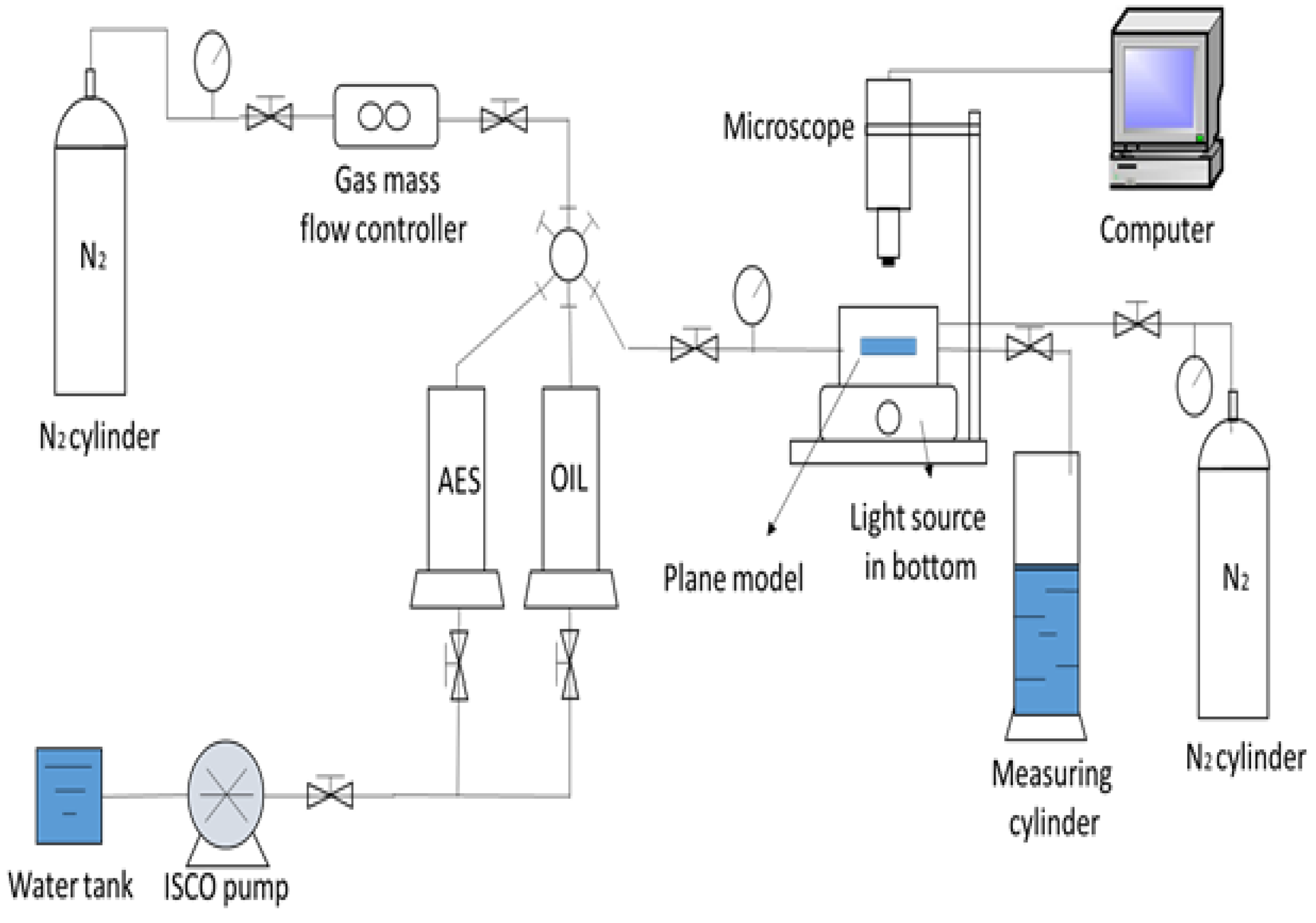
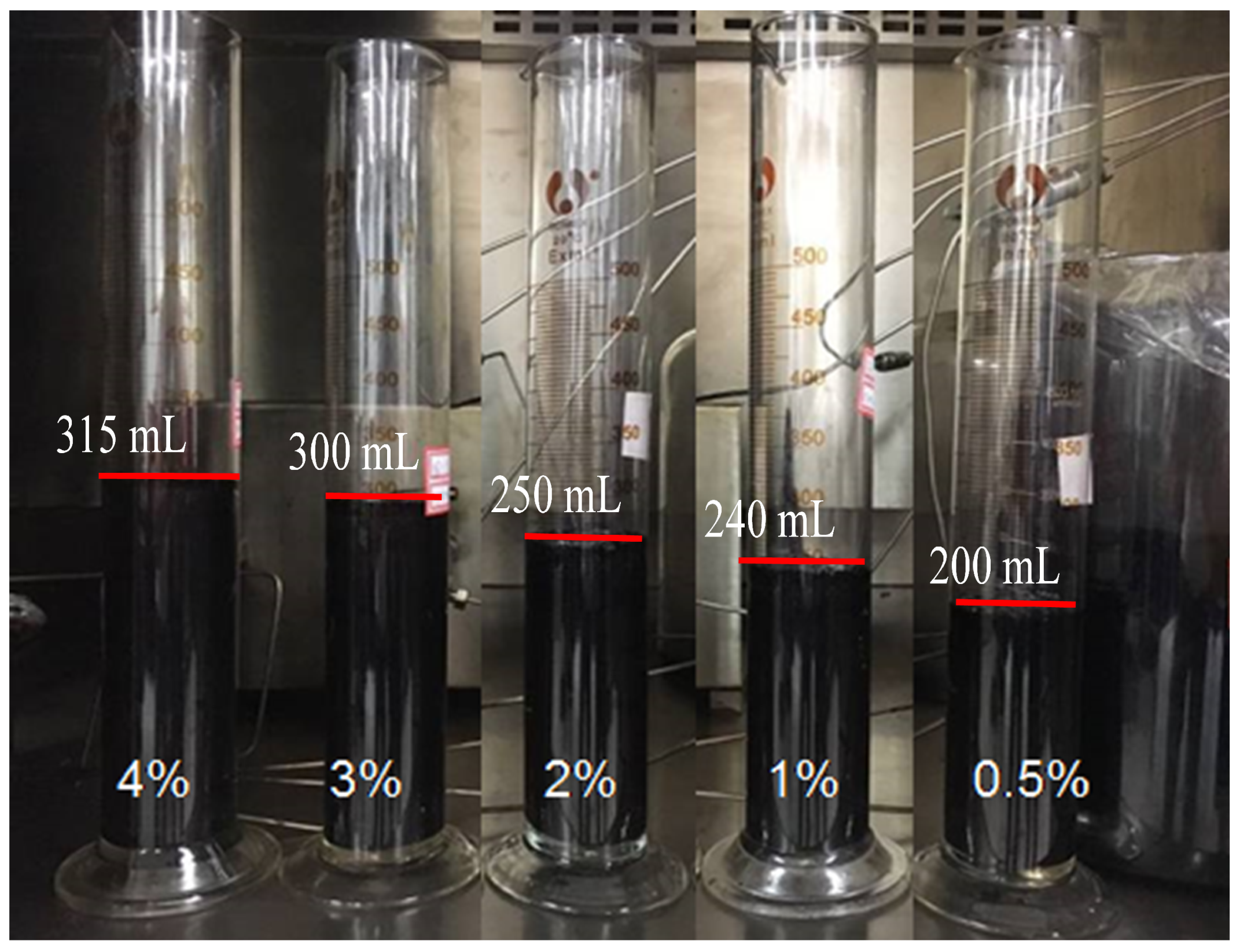
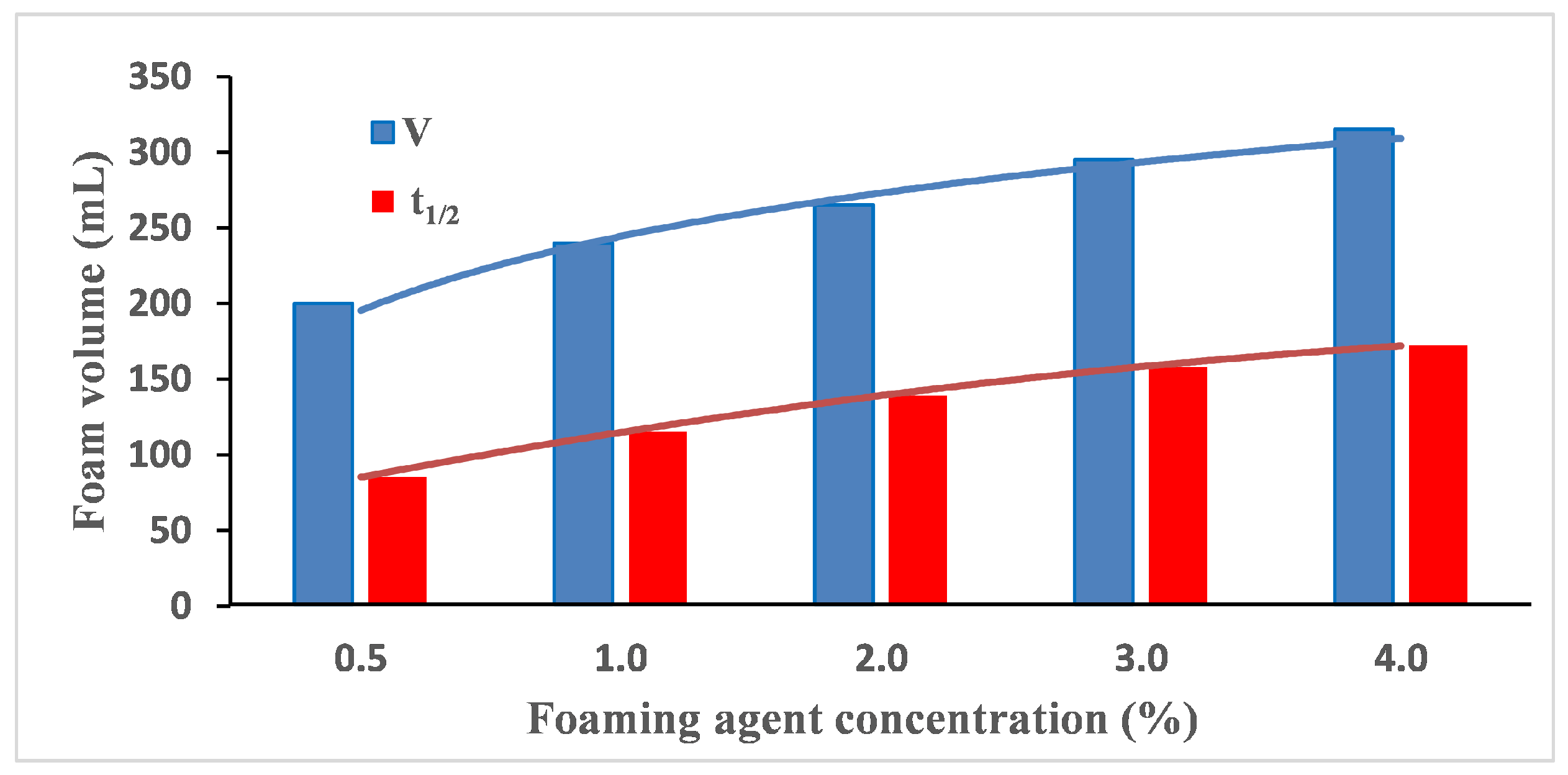
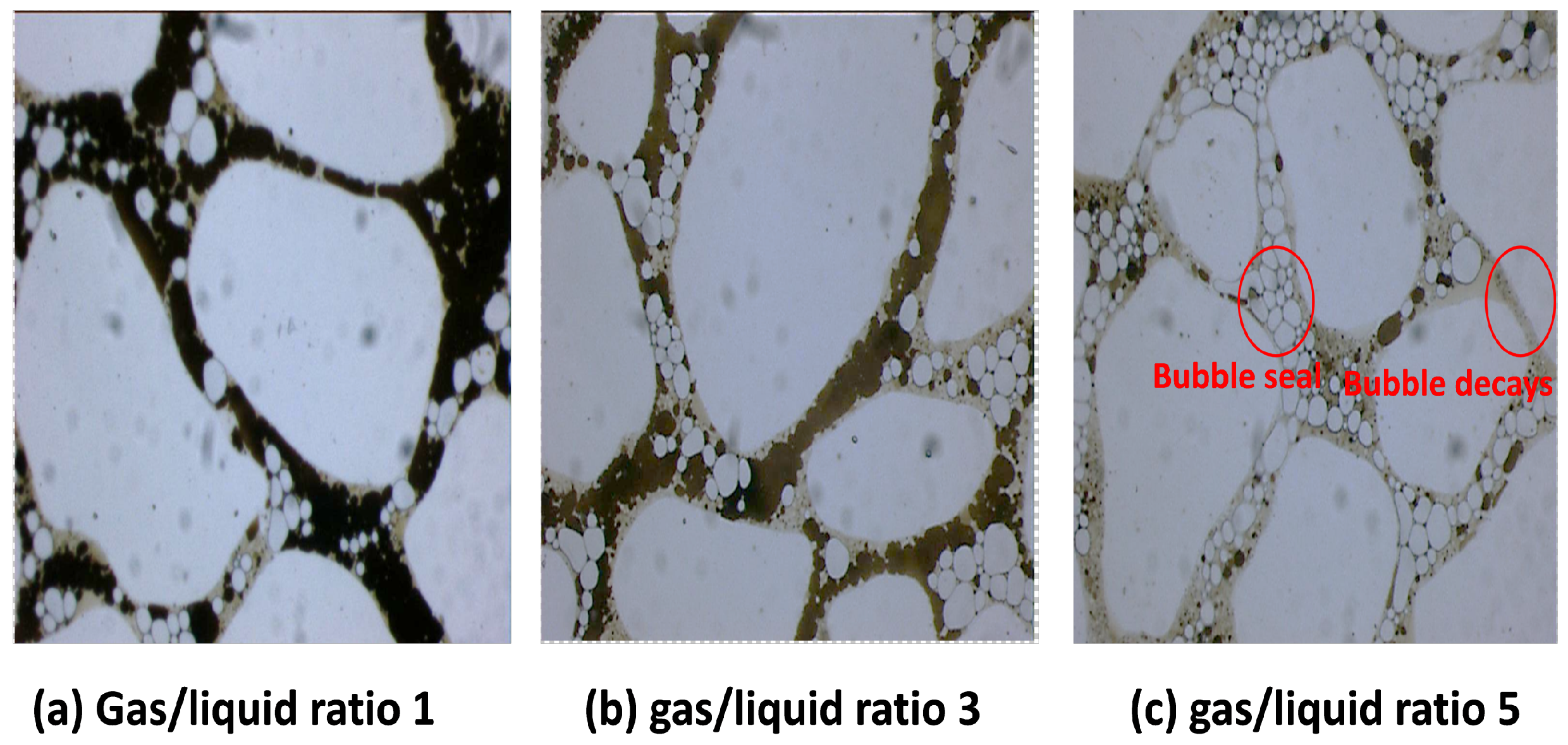
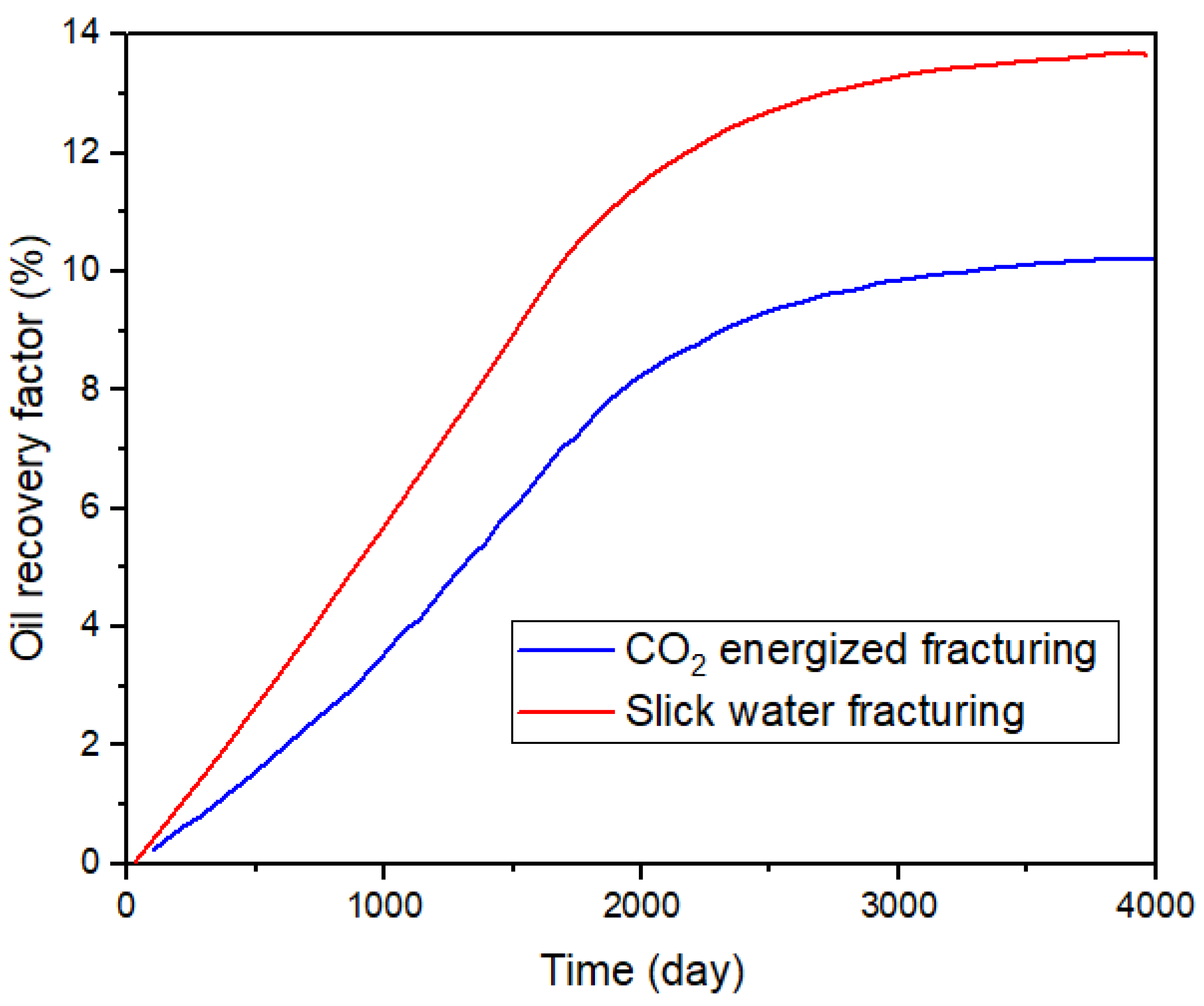
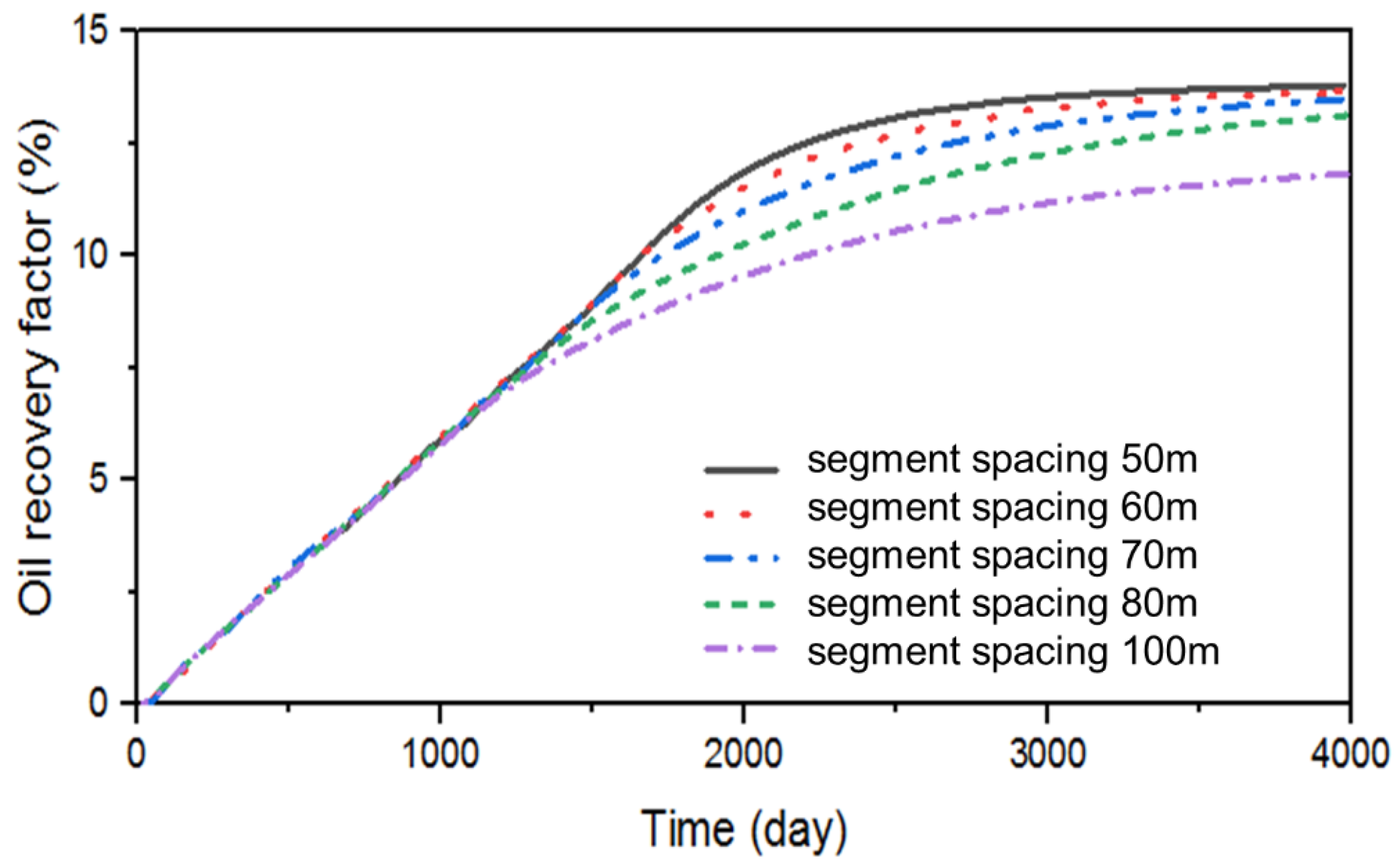
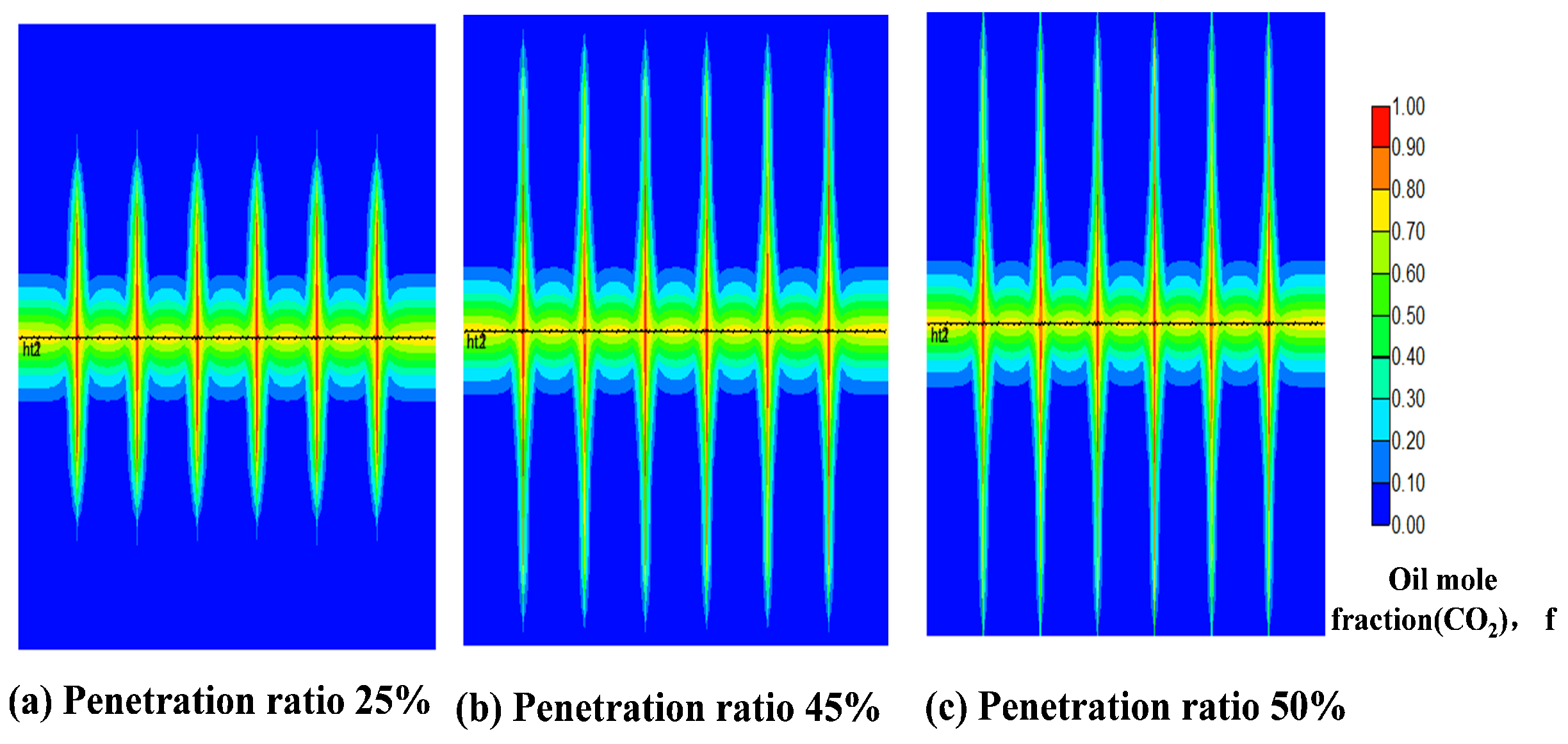
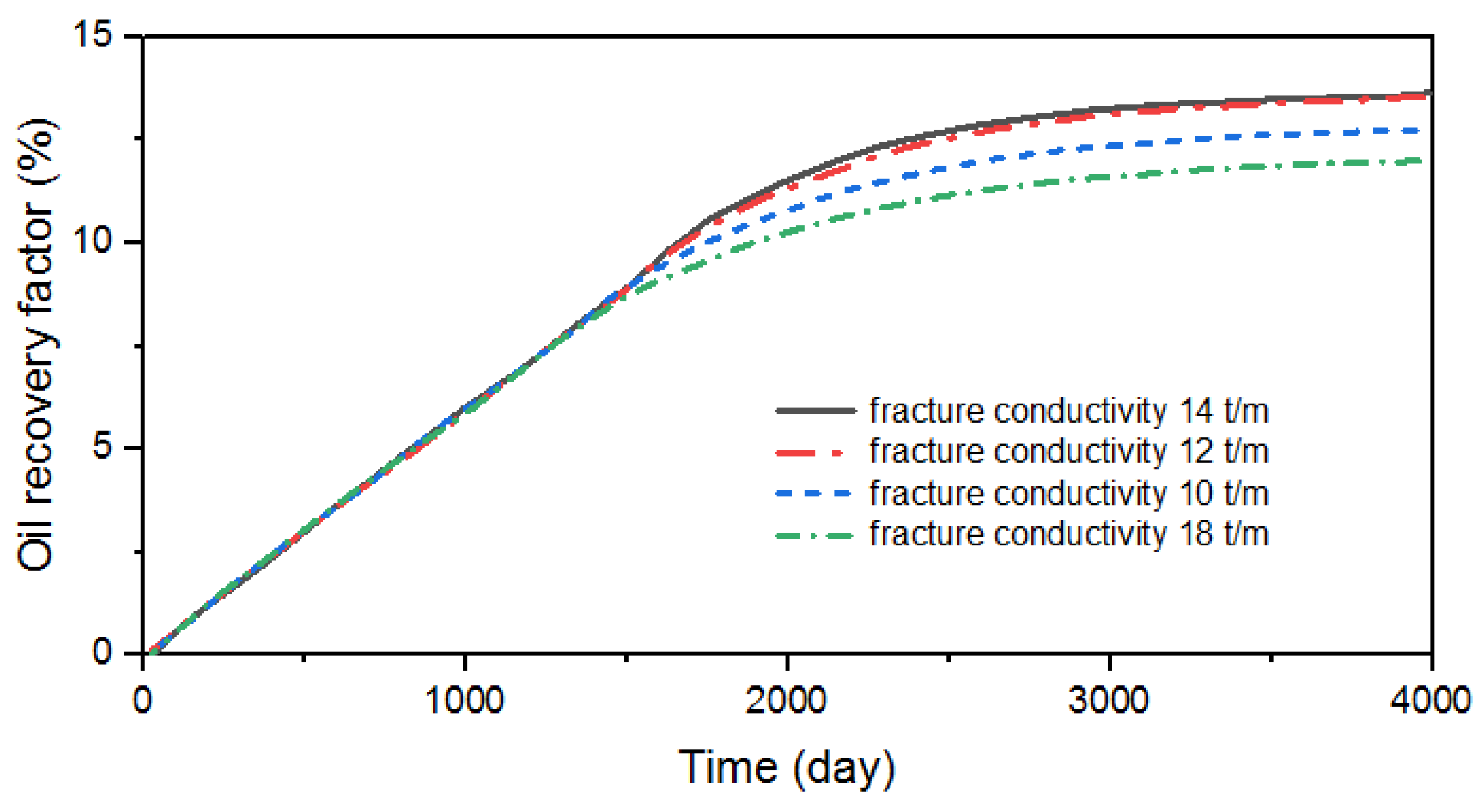
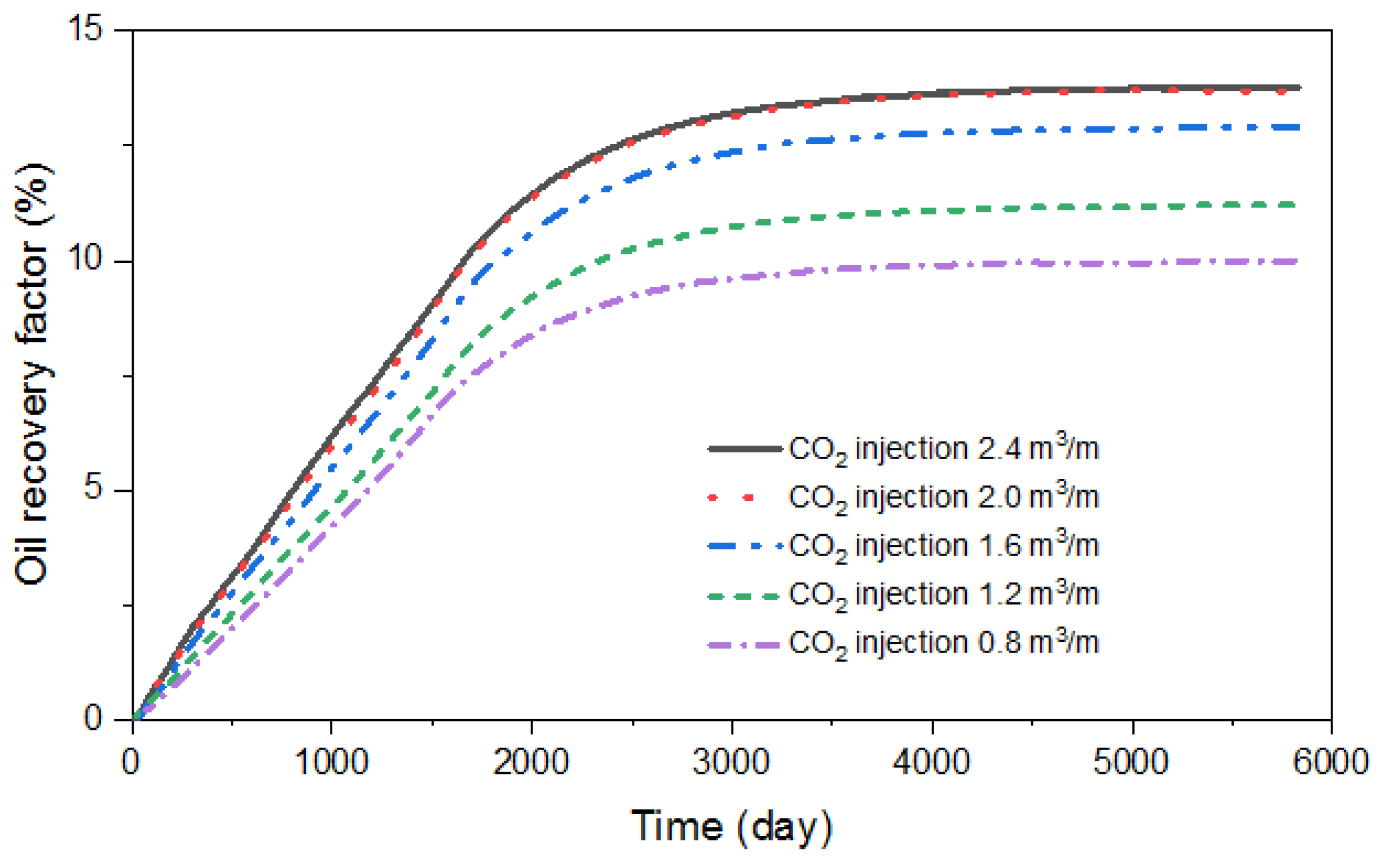
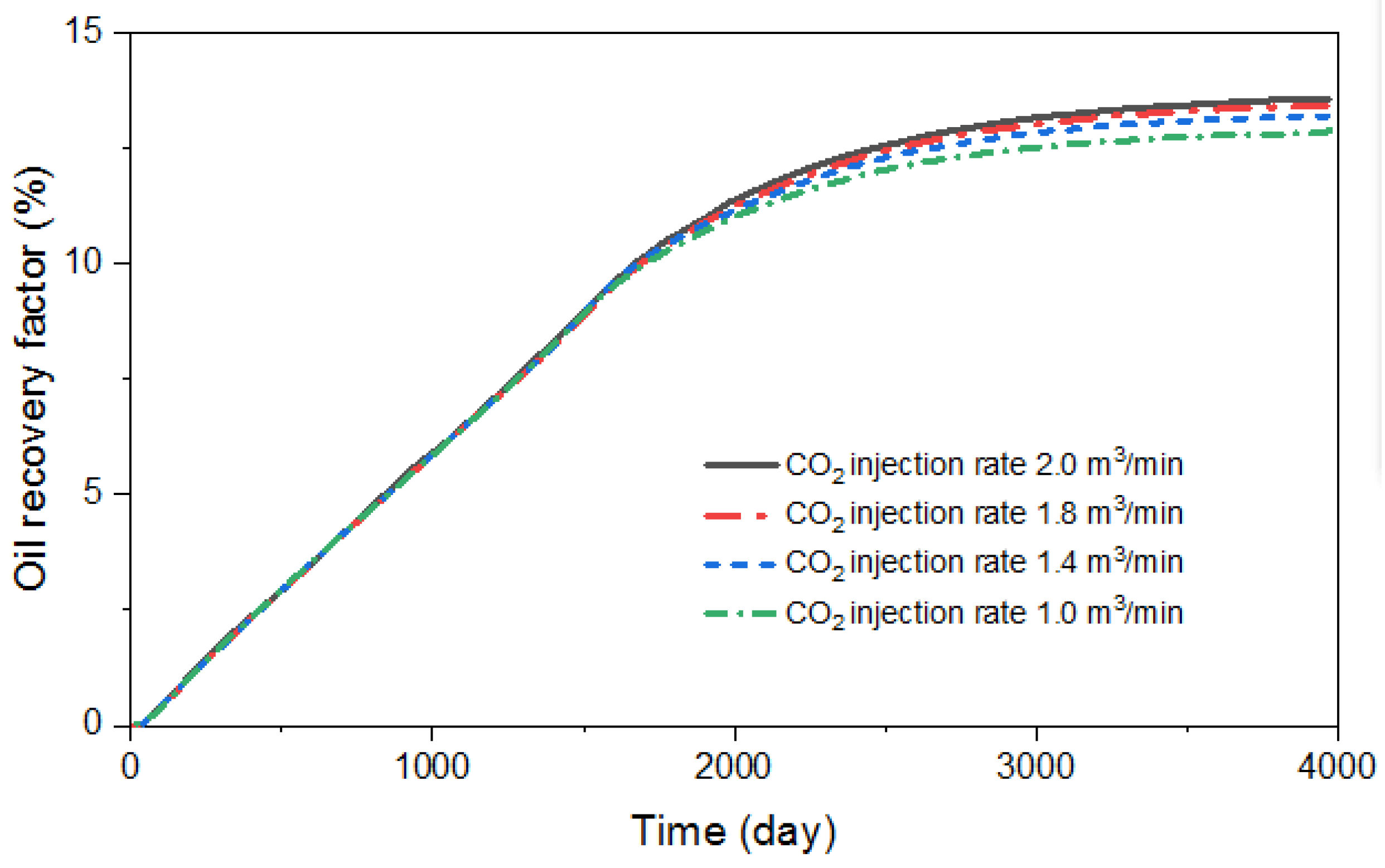
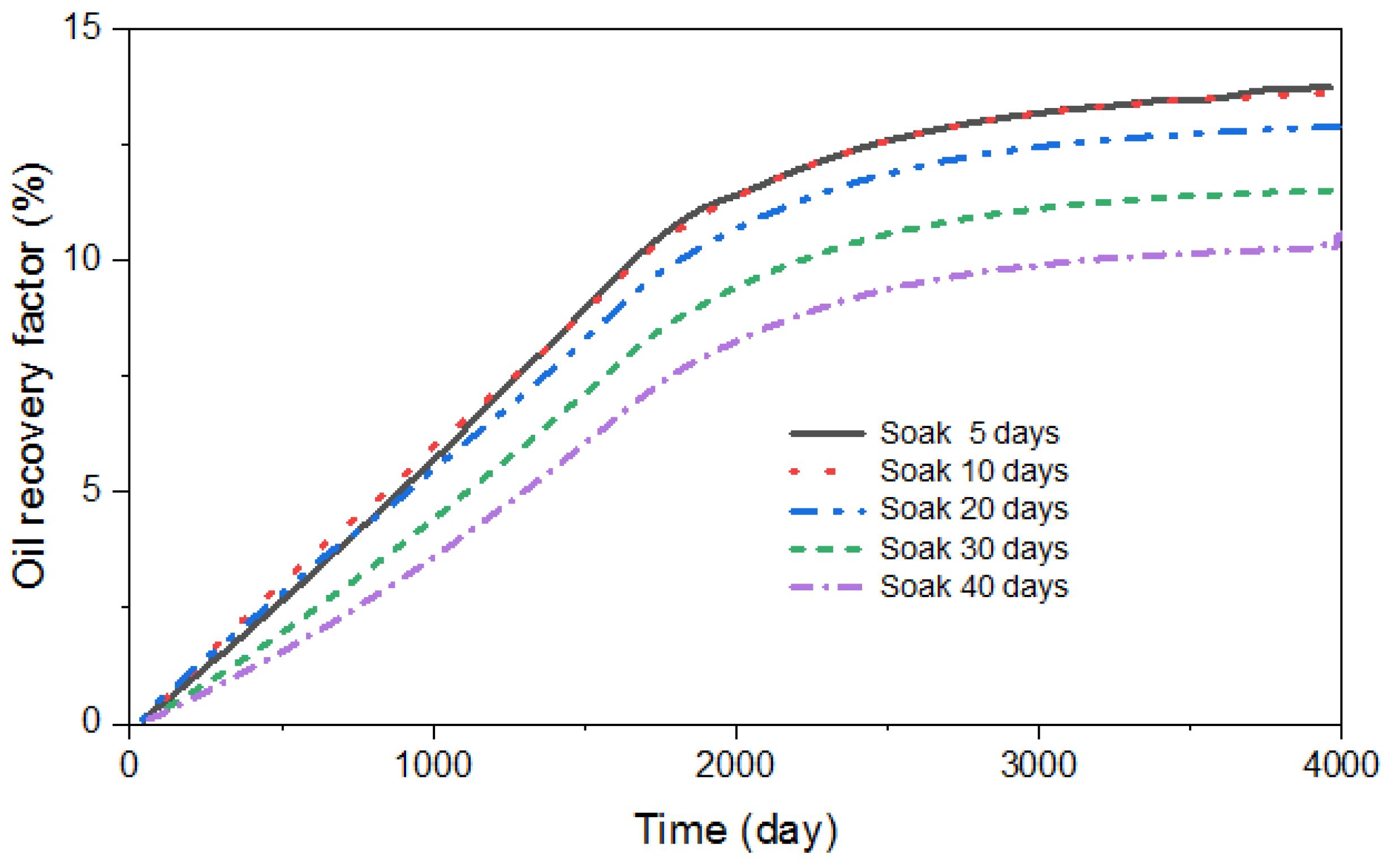
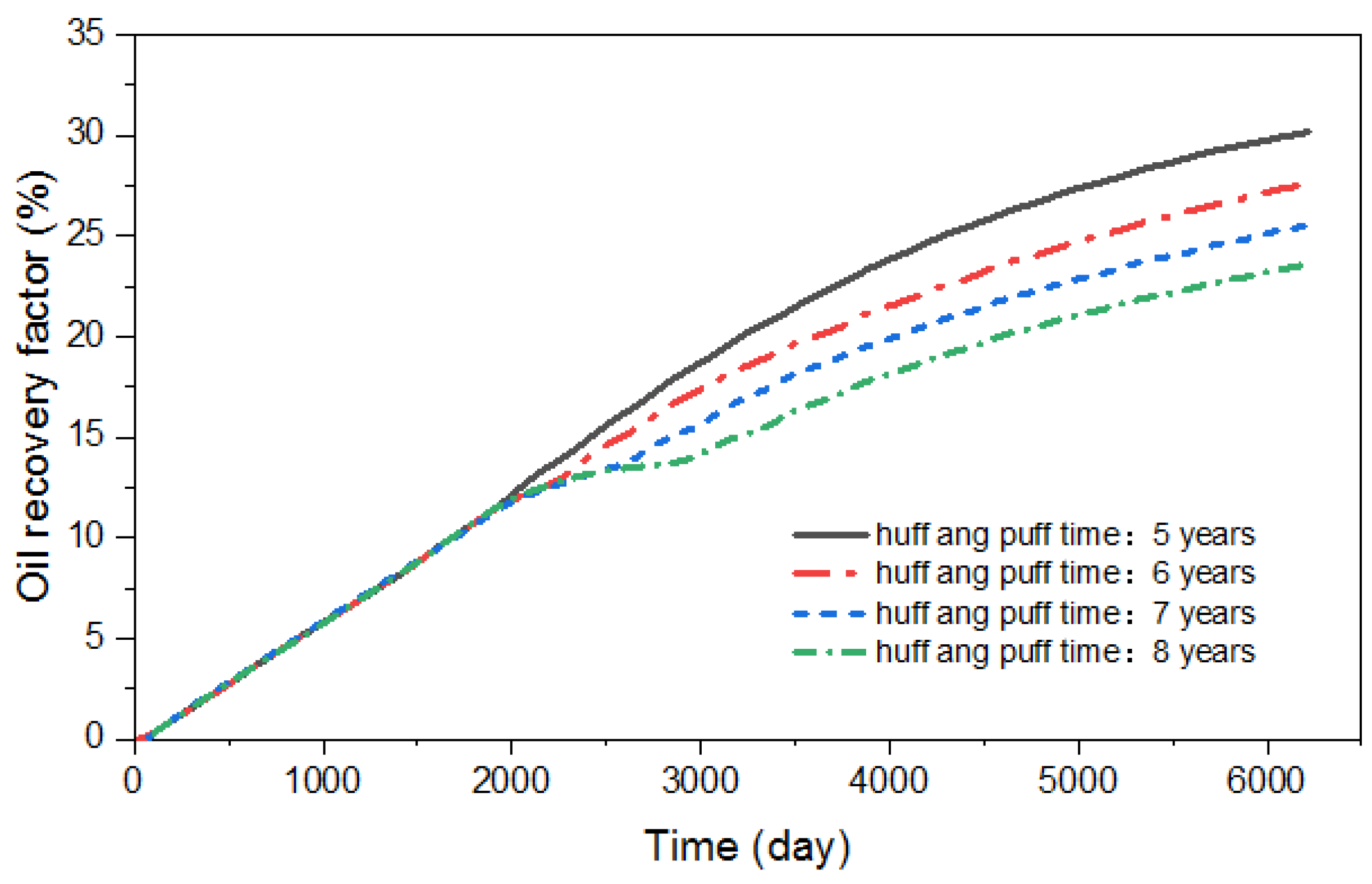
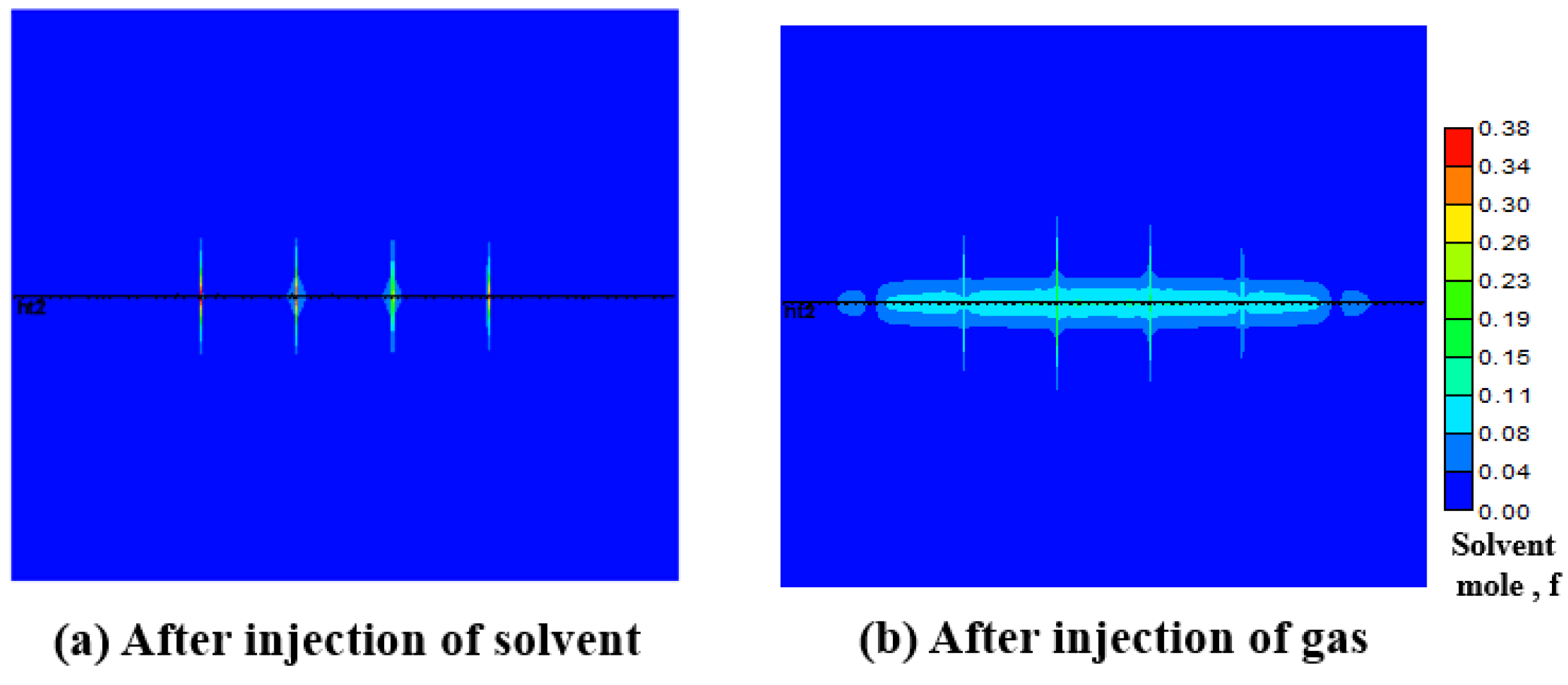
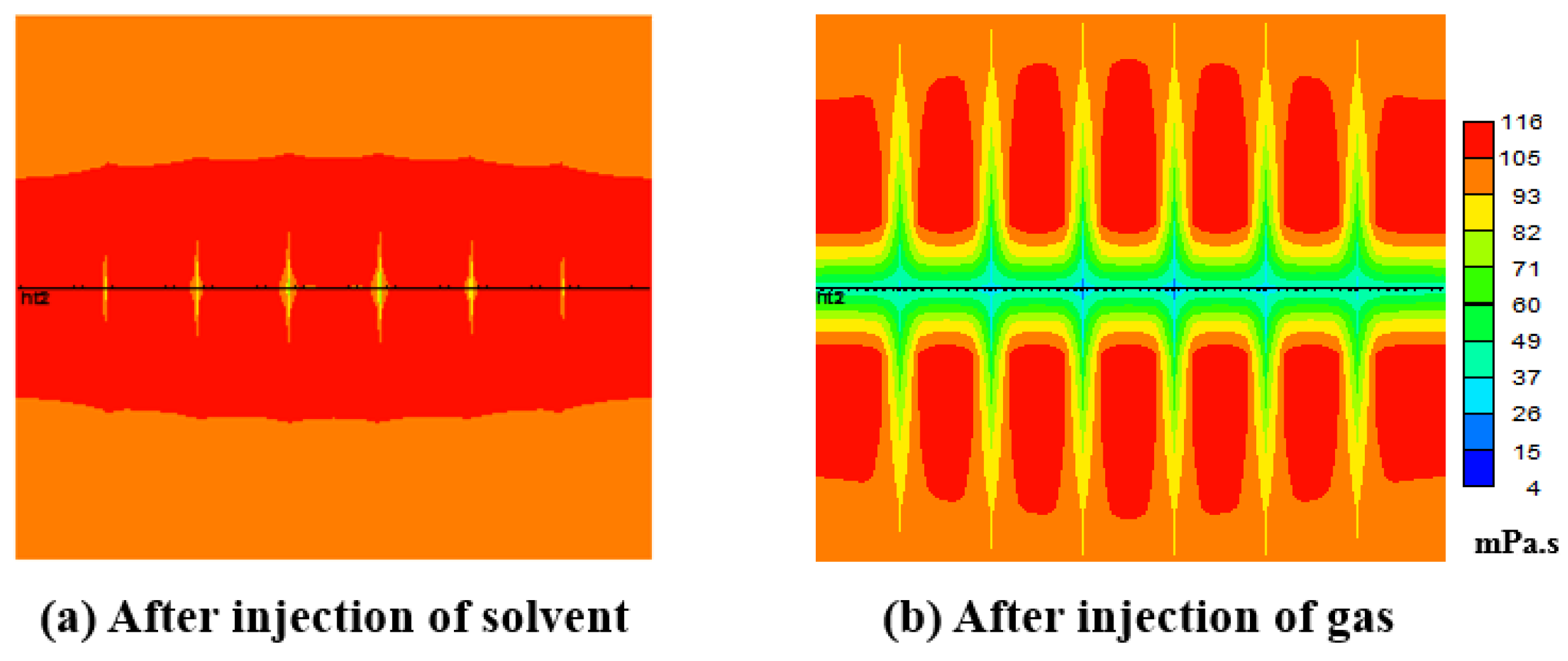
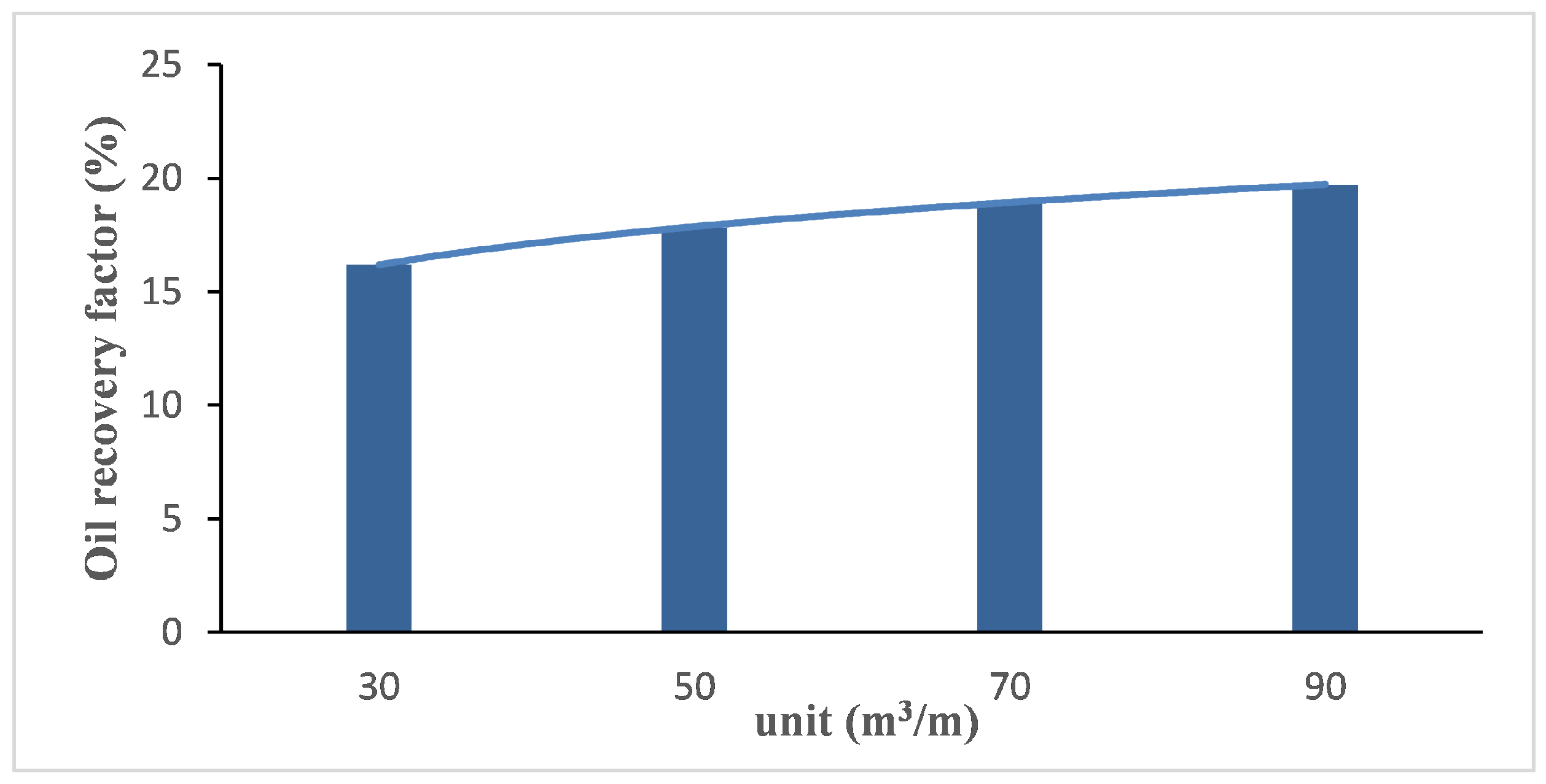
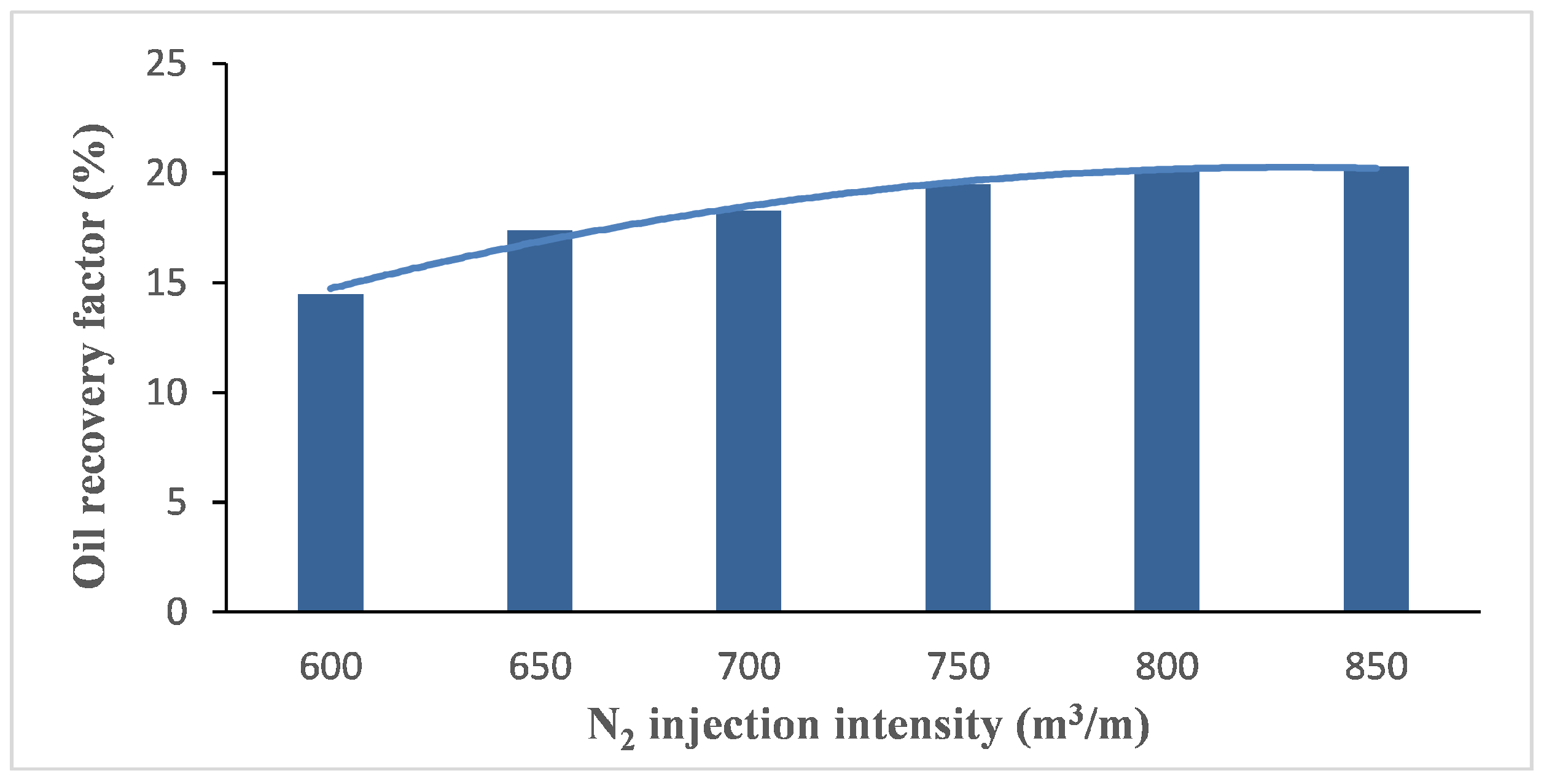

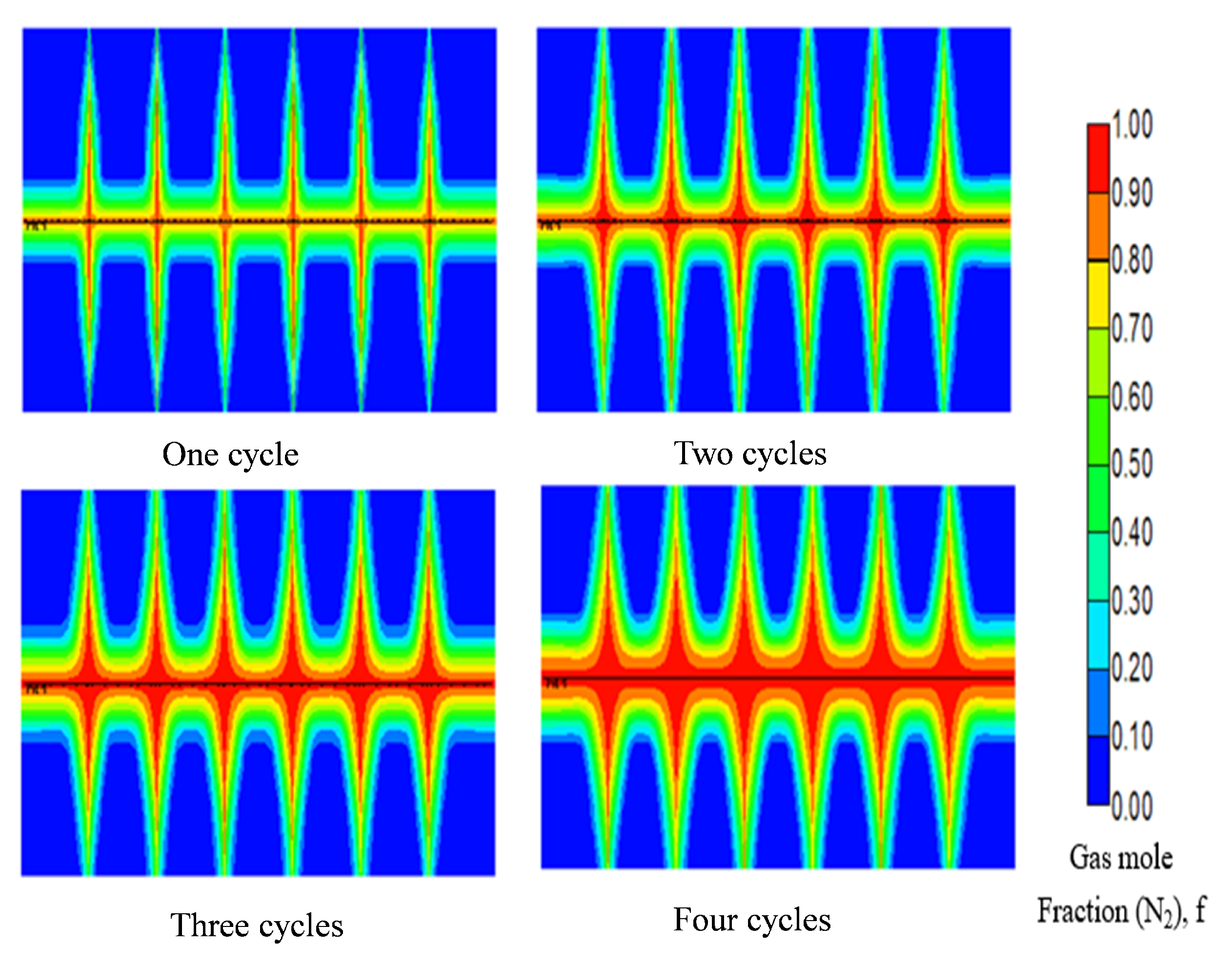


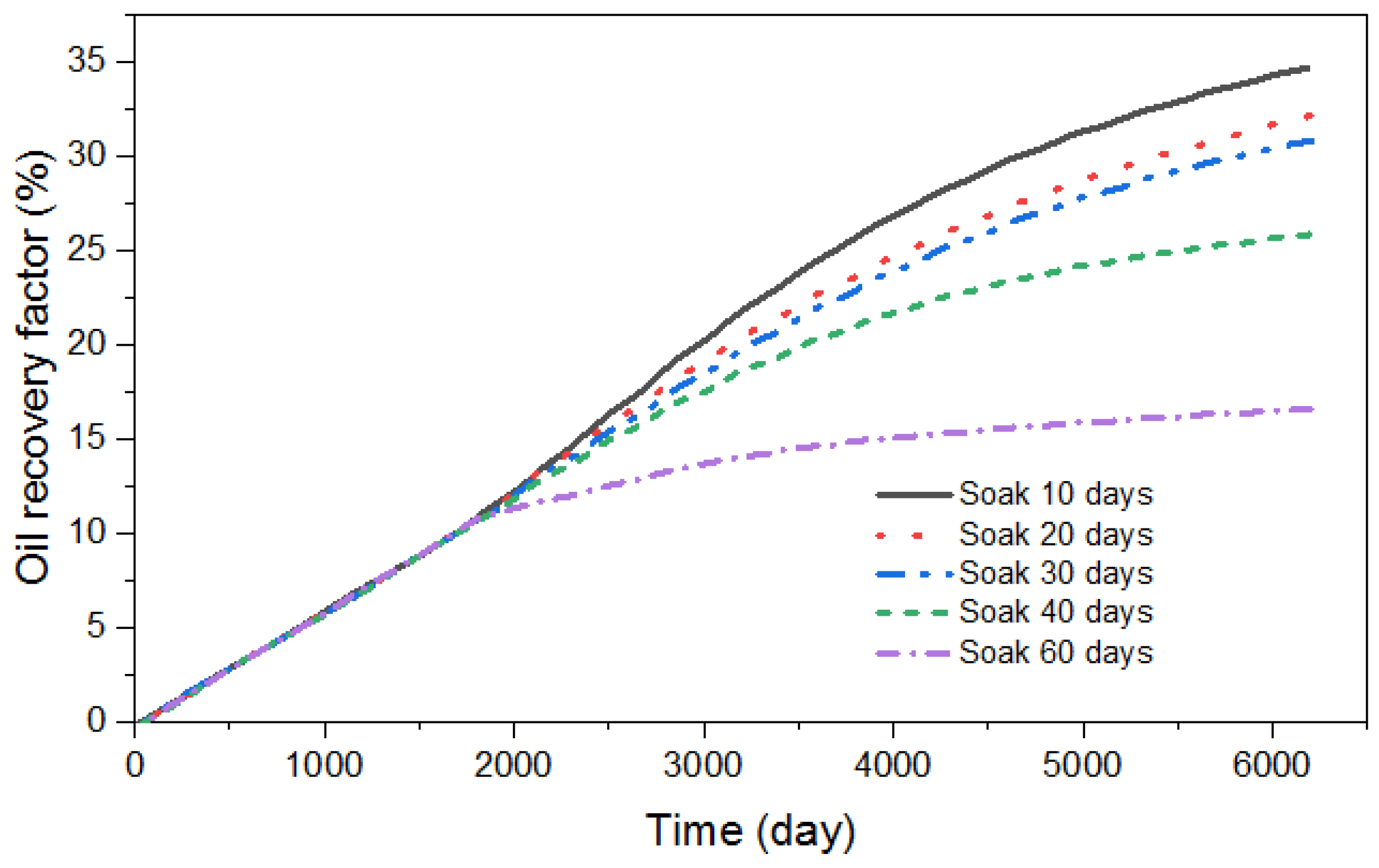
| Item | Value | Item | Value |
|---|---|---|---|
| Reservoir buried depth (m) | 1257.0 | Formation dip angle (°) | 16.5 |
| Thickness (m) | 12.9 | Porosity (%) | 21.1 |
| Formation temperature (°C) | 35.4 | Oil saturation (%) | 56.9 |
| Oil viscosity (mPa·s) | 102.3 | Permeability (mD) | 20.6 |
| Oil density (g/cm) | 0.833 | Rock compressibility (1/MPa) | 2.2 |
Disclaimer/Publisher’s Note: The statements, opinions and data contained in all publications are solely those of the individual author(s) and contributor(s) and not of MDPI and/or the editor(s). MDPI and/or the editor(s) disclaim responsibility for any injury to people or property resulting from any ideas, methods, instructions or products referred to in the content. |
© 2023 by the authors. Licensee MDPI, Basel, Switzerland. This article is an open access article distributed under the terms and conditions of the Creative Commons Attribution (CC BY) license (https://creativecommons.org/licenses/by/4.0/).
Share and Cite
Sun, S.; Wu, Y.; Ma, X.; Liu, P.; Zhang, F.; Liu, P.; Zhang, X. Feasibility and Mechanism of Deep Heavy Oil Recovery by CO2-Energized Fracturing Following N2 Stimulation. Energies 2023, 16, 1161. https://doi.org/10.3390/en16031161
Sun S, Wu Y, Ma X, Liu P, Zhang F, Liu P, Zhang X. Feasibility and Mechanism of Deep Heavy Oil Recovery by CO2-Energized Fracturing Following N2 Stimulation. Energies. 2023; 16(3):1161. https://doi.org/10.3390/en16031161
Chicago/Turabian StyleSun, Shuaishuai, Yongbin Wu, Xiaomei Ma, Pengcheng Liu, Fujian Zhang, Peng Liu, and Xiaokun Zhang. 2023. "Feasibility and Mechanism of Deep Heavy Oil Recovery by CO2-Energized Fracturing Following N2 Stimulation" Energies 16, no. 3: 1161. https://doi.org/10.3390/en16031161
APA StyleSun, S., Wu, Y., Ma, X., Liu, P., Zhang, F., Liu, P., & Zhang, X. (2023). Feasibility and Mechanism of Deep Heavy Oil Recovery by CO2-Energized Fracturing Following N2 Stimulation. Energies, 16(3), 1161. https://doi.org/10.3390/en16031161








